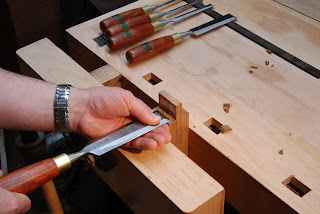bugbear":3pzmcp3n said:
YorkshireMartin":3pzmcp3n said:
Since cutting a mortice is similar to chopping shoulders
I've read about an awful lot of variations on processes, but I've never heard of "chopping shoulders".
They're normally sawn (cross cut), and then pared (or shoulder-planed) if the sawing wasn't dead on.
Could you expand a little please - I'm always happy to learn about a new thing.
BugBear
I've been trying out quite a few different methods. Some of which I'd read about on here and others that I've seen on youtube.
I've found that when I saw the shoulders, I'm getting what appears to be a slight blade deflection (all I have is a rip tenon saw although read this was ok for small shoulder cuts- although this may be why?). I was cutting away from my knife line of course then trying to plane it down. This didn't go too well and I seemed to constantly get a raised area in the center of the shoulder.
Due to the above I then tried something else.
I attempted to make a "fence", chiseling (by hand) along the knife wall at about 30 degrees and removing a little bit of material. I found this helped to guide the saw at the start of the cut, a shallow fence if you will. Still, I found I needed to remove just a tiny bit of material with the shoulder plane. Again it left and uneven shoulder after planing, although the saw cut was much better.
So after all of the above, I concluded that I need to tinker with my shoulder plane. It's sharp, but I think it might be a tad large for this job. It's a 73 and the shoulders were 1cm so quite difficult for me to balance.
In the end, what I did was to make chop cuts with the chisel along the shoulder knife line, taking great care to ensure the chisel was vertical. I followed the line along the shoulder, then hand pared the chisel from the tenon end in blocks. I found as I got better at it, I could increase the size of the blocks I was removing.
The end result of that was shoulders which were nigh on perfectly square, with a tenon to match, something I hadnt been able to come close to with a saw/plane combo.
I noted that I had to pay attention to the grain direction though, to avoid break out affecting the thickness of the tenon. This was particularly a problem when I encountered what was a previously hidden knot, slap bang in the center of a tenon. Had to patch that one up with some shavings.
The end result isn't too bad, but I need to refine the finish. If I'm going to make any decent furniture, gaps, even fractions of a millimeter, aren't acceptable to me.































